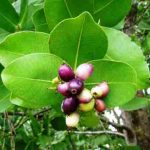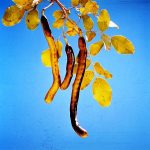TREE LIFE
DECEMBER 2006/JANUARY 2007
The Chairman and members of the Committee would like to wish all members and their families a very happy Christmas and interesting walks in 2007
MASHONALAND CALENDAR
Sunday 10th December: Christmas Social. We had originally planned to hold this at the Education Centre at the Botanic Gardens. However, this has been badly damaged by fire. We are therefore moving the venue to Bill Clarke’s property Val D’Or where we have held Christmas Socials before.
Our thanks go to Bill for agreeing to host us at short notice.
After tea, which will be served at 9.30 a.m., we will have a walk led by Meg Coates Palgrave. Rob and Adele have compiled another general knowledge quiz, which will take place before lunch.
Please bring some Christmas fare to share for tea, and bring your own lunch, a wine glass and a chair.
Sunday 1st January 2007: Mt Hampden. This is my 4th Saturday afternoon walk, deferred until after Christmas. We have arranged a visit to Mr Rourke’s plot at Mount Hampden (quite close to Jean Simon). Meeting time: 2.30 p.m.
Sunday 21st January: Rainy season visit to Mazvikadei.
We hope to go up to Mazvikadei on the Friday and return on Sunday or Monday. Anyone interested in staying for this longer period, which will be self-catering, please contact Adele. Otherwise, we will have the normal Tree Society walk for those travelling up there on Sunday 21st. We will meet at Stand 139 at 9.30 a.m.
Saturday 27th January: Domboshawa.
An old favourite, which should be very interesting in the rains.
Take the Borrowdale Road out of Harare and continue for ± 33 km. Watch out for speed humps, pot holes, pedestrians, cyclists, chickens and dogs. Turn right at the Domboshawa Cave sign (if it is still there) and continue to the car park where we will meet at 2.30 p.m . Bring your lunch, water and a rain coat.
TOM MULLER. First the bad news about the fire. Now we have just heard that Tom Muller has broken his Achilles tendon. We understand that he is in plaster and may be immobile for 6 weeks. The sympathies and very best wishes of the Society and its members go to Tom and we wish him all the best for a speedy recovery.
We will let you know when Tom is available again to resume the Botanic Garden walks.
MATABELELAND CALENDAR
Please contact Jean Wiley or Gill Short for details of the next Matabeleland function.
CHRISTMAS EDITORIAL
As I will be particularly busy at the end of December, we have decided to have a double issue of Tree Life, covering the 2 months of December and January.
If there are any changes to any of the outings we will notify members by email. Perhaps those who are not on email could contact a Committee member to make sure that the arrangements are unchanged.
In the 6 editions I have edited, I have been very pleased by the number of articles submitted by members of the Society. All I can say is – keep up the good work; more are always needed.
Mark Hyde Editor
LOWDALE, MAZOWE VALLEY, 15TH OCTOBER 2006
The October Sunday outing of the Tree Society was held at Lowdale Farm, the home of the Townsend family, on the upper reaches of the Mazowe River. We had a choice of routes to the farm, either via Alpes Road and Welston, or via Christon Bank. Although the Alpes Road route had been the better at the time of announcing the venue, the Christon Bank route was preferable on the day, as John Bredenkamp had just repaired the road down into the valley in preparation for his daughter’s wedding. Members rolled into the farm over a period of an hour, either smiling or frowning, depending on which route they had chosen and whether or not they had got lost on the way.
We gathered at the farm homestead. Brian Townsend was away, but the maid kindly allowed us leave the cars in the security fenced enclosure. The turnout was surprisingly good, considering the heat and the scarcity and price of fuel; 19 members and guests were there. After some debate we decided to walk down to the river, rather than take the cars, as it was considered unsafe to leave vehicles unattended in the area. Meg Coates-Palgrave led us through a series of broken-down barbed wire fences to a wide farm track that led to the river behind the house. The wire was too much for Tony Ade, who retired hurt to the cars.
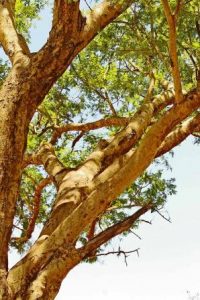
Acacia sieberiana. Photo: Meg Coates Palgrave. Source: Flora of Zimbabwe
The track was lined with three Acacia species, and we had a good opportunity to compare them. Meg was able to illustrate the differences between A. sieberiana and A. polyacantha, both very common pioneer species in the Harare area. The former has straight spines and branches dichotomously, each main branch splitting into two equal branches, which results in the characteristic flat top. Acacia polyacantha has hooked thorns, which Meg calls prickles, and produces lateral branches from a single trunk, which gives it its upright shape. The third species was a bit of a puzzle; the striking features were the straight spines and the small number of pinnae pairs and leaflets, but the bark was unremarkable.
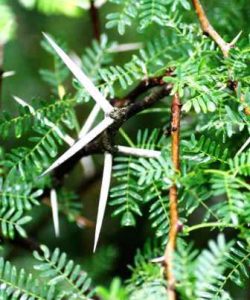
Acacia karroo. Photo: Bart Wursten. Source: Flora of Zimbabwe
It could have been A. karroo or A. robusta, which is sometimes mistaken for A. karroo but is thought not to occur in that vicinity. The finding of a few old, delicate, crescentic pods on the ground under some of the trees confirmed the identification as A. karroo. Many of the Acacia were infested with a parasitic Viscum sp., an untidy cluster of leafless round stems hanging from a branch. Members of the genus are known as Mistletoes. The Flora of Zimbabwe website shows that there are several species in Zimbabwe, but only one is described and illustrated so far, and it is not the Acacia parasite. The genus presumably gets its name from the stickiness of the seeds, which stick to birds’ beaks and are implanted on a new tree when the bird tries to clean itself. Two unusual trees along the track were Rhus lancea, known as the Willow Rhus because of the long, narrow, willow-like leaflets on its trifoliolate leaves, or in South Africa as the Karree; and Gymnosporia maranguensis, the Tropical Spike-thorn, formerly and better known to most of us as Maytenus senagalensis, which was covered in small white flowers.
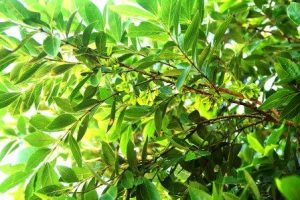
Combretum erythrophyllum. Photo: Bart Wursten. Source: Flora of Zimbabwe
At the end of the track was the river, quite narrow and fast flowing where it crossed an old drift, and pleasantly clean. On the near side of the river was an attractive, cool grove of predominantly Celtis africana, while the river itself was lined with Combretum erythrophyllum. Both were in fresh green leaf. Celtis leaves are fairly easy to recognize, being simple, alternate and asymmetrical, with three main veins from the base and the margin toothed in the upper two-thirds. The smooth grey trunk and the situation near water clinch the identification.
Combretum erythrophyllum is a real challenge to the compiler of tree keys, as the leaves can be opposite, alternate or in whorls, all on the same branch. If the four-winged pods are present, that’s a give away, coupled with the smooth grey bark and the riverine habitat. Diospyros lycioides and Rhamnus prinoides were present in the understorey. The Diospyros is ubiquitous, but we don’t see the Rhamnus that often, which is a pity, because it is a very attractive riverine shrub with brightly shiny leaves and edible, red berries in season.
The party sat in the shade by the river and steadfastly resisted Meg’s attempts to lead the expedition up along the bank. “Every yard we go will be a yard further to walk back in the sun for lunch”. So back to the house we went along the track, bypassing the barbed wire obstacles, and spent a very sociable hour under the trees before returning to town, the whole party via Christon Bank.
I’m sorry to say that the most spectacular trees on the farm were the Jacarandas, much reviled by tree enthusiasts. There were great groves and belts of them among the farm buildings, all in spectacular bloom, adding wonderful colour to a dry, October landscape. One ignores exotic trees at one’s peril, because they are a feature of the African bush.
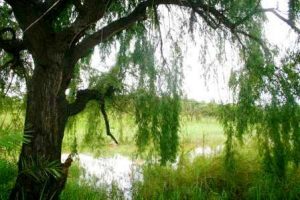
Salix babylonica. Photo: Bart Wursten. Source: Flora of Zimbabwe
Down by the river I saw Salix babylonica, the European Willow; Morus australis, the Mulberry; Melia azedarach, the Syringa; Solanum mauritianum, the Bugweed; Senna septemtrionalis; Ricinus communis, the Castor-Oil Tree; Citrus limon, the Lemon; and Rubus niveus. Some of these are very unwelcome invaders, and one is unlikely to find them in tree keys, but they are there.
We say thank you to Brian Townsend for allowing us to visit the farm and enjoy a day in the country, and to Meg for giving us her time and sharing her experience to make the day so interesting.
-John Lawrence
TREE SOCIETY MAPPING PROJECT
The Tree Society mapping project was launched in March 1989 through an article in the Tree Life of that month (no. 109).
The way it works is that recording is done on a quarter degree square basis – that is one quarter of a degree of longitude from east to west and a quarter degree of latitude from north to south. The resulting “squares” (which are not exact squares) are approximately 25 × 25 km. There are about 600 of them covering the whole of Zimbabwe.
Many of our members have contributed records to the project: Kim Damstra, Meg Coates Palgrave, Maureen Silva-Jones and many others.
For many years the project has been managed by Maureen Silva-Jones. Initially, records were made by hand on printed maps. About 5 years ago, a computer mapping program, DMAP, was purchased and the records have since been captured by Maureen in electronic form.
Recently, we have sorted out a problem with the software and have purchased an upgrade to the latest version.
A lot of work has been done and there is an impressive database of records. Although this is perhaps not the best time to relaunch the project, not least because of the difficulties of traveling, we are hoping to begin collecting records once again.
It is also intended to make the records available on the web so that those with internet access can see the present state of the project and which squares a particular species has been recorded from.
Maureen has agreed to carry on with the project. New records would always be welcome.
Mark Hyde
MORE ABOUT MISTLETOE
At a recent Tree Society visit to Mazvikadei, parasitic plants were looked at in some detail. This reminded me of when I was collecting Shangaan plant names for the late Peter Biegel for inclusion in the revised edition of Wild’s Botanical Dictionary.
The Shangaans are great field botanists, and parasitic plants growing on trees are for them significant medicinal plants. They call them “njunju” . The value of the plant varied, depending on the host. The most important were those growing on Combretum imberbe (“monzo” to the Shangaans), and the parasitic plant for this tree is known as “njunju re monzo”. Interestingly, their name for marine coral is “ribwe njunju”, and is also used medicinally. (“Ribwe” is the Shangaan word for stone).
In The Traditional Medical Practitioner in Zimbabwe published by Mambo Press, Loranthus spp. are recorded as being used extensively, and for a variety of ailments. Some are also used for magical and spiritual purposes. Again the host species is important.
As a result of recent revisions of the genus, what we used to call Loranthus are now in a number of genera, of which Agelanthus and Tapinanthus are probably the most important.
-Peter Taylor
MARK HYDE CHAIRMAN


